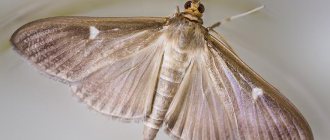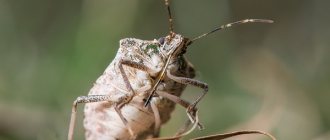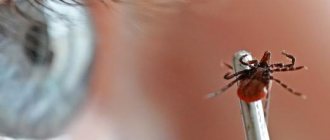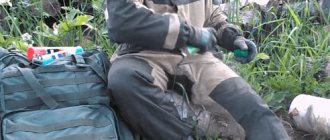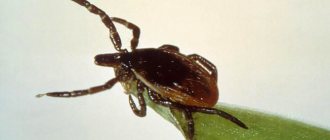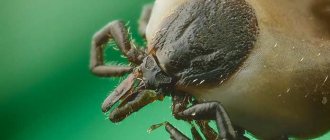Appearance of a tick
Scientists call granary or tyroglyphoid mites chewing mites; they received this name because of the specific structure of the claws with which they bite off their food. It is difficult to detect parasites with the naked eye; they are very small and can only be seen under a microscope. They can be recognized by the following signs:
- the tick is small in size, only 0.2-0.5 mm long;
- the body is oval, whitish in color, translucent;
- four pairs of legs.
A distinctive feature of the pest is its simplest structure; it does not have complex organs. The tick breathes with its entire body through spiracles on the skin, which cracks at low humidity and the pest dies.
Important!
It can be difficult to determine that a product is infected with a mite; this can be diagnosed in different ways. The most effective trick is to use double-sided tape; stick it on the door of the food cabinet, and check after a day to see if you still get a few parasites.
Barn mite
There are variants of mites with a slightly reddish, almost rusty color; they are better visible on flour.
Why is a tick dangerous?
Ticks are very small in size and are usually difficult to notice until they have sucked blood. But then it’s already too late. When a tick lands on a person’s body, it does not immediately dig into his skin, but crawls for a long time, looking for the most tender places (where the skin is thin). Most often it digs into the groin area, armpits, neck, collarbone area, stomach and back. Its bite is completely insensitive, because the tick's saliva contains an anesthetic substance. Ticks stick for three to four days. From drinking blood, the ticks swell greatly, increasing in size three to four times, and only then fall off. Ticks are dangerous not because of their bite, but because they suck blood from various animals, and from each animal they acquire microbes. Then these microbes are introduced into the victim’s blood. The most common is the forest tick. It is a carrier of tick-borne encephalitis, a severe disease of the central nervous system. Ticks can also transmit other serious diseases, including plague, tularemia, borreliosis, brucellosis, and typhus.
Even if the tick bite was only temporary, the risk of contracting tick-borne infections cannot be ruled out. However, you need to understand that the presence of an infection in a tick does not mean that a person will get sick.
When is a tick dangerous?
The tick is most dangerous in the spring-summer period; in August the risk of infection decreases sharply, and in September-October it practically disappears.
Ticks are most active in the morning and evening; they love shaded, damp places with dense undergrowth. They usually do not appear in bright places. Ticks love to be near paths where animals (including mice) walk. They love places where cattle graze, various clearings and remote places. In hot weather or rain, ticks hide and do not attack. Don't forget that ticks crawl from bottom to top. It is a mistaken belief that ticks attack from trees or tall bushes. They lie in wait for their “prey” among the vegetation of the lower tier of the forest (usually no more than 1 m in height). In tall grass, ticks have better protection from sunlight and are more likely to attack.
Bitten by a tick, what to do
A tick bite is painless, only after a day or two does a feeling of slight nagging pain arise, as a local inflammatory reaction develops at the site of suction, sometimes with suppuration. The bite wound is usually very itchy and heals very slowly. If you notice a bite, you can remove the tick yourself or go to the clinic.
How to remove a tick
You can remove ticks yourself using tweezers, a loop of strong thread (this method requires skill) or your fingers, preferably disinfected with an alcohol solution. If the tick has already burrowed deeply into the body, you can drip vegetable oil or Vaseline onto the bliss, something that envelops and blocks the access of air. You need to pull out the tick by slightly rocking it from side to side, and then gradually pulling it out. If the proboscis comes off and remains in the skin, then it is removed with a needle heated in a flame and cooled, like a splinter. Even if you do not completely remove the parasite and the proboscis remains under the skin, intoxication with the virus will occur more slowly. When providing first aid for a tick bite, avoid all contact with the parasite, as the danger of transmission of infection is real and present. Try to prevent the places where the tick has attached itself from coming into contact with the mucous membranes of the eyes, mouth and nose.
What to do with a tick after removal
It is important to know that in no case should you destroy removed ticks by crushing them with your fingers, since if you accidentally crush a tick, infection can occur as a result of rubbing the infectious agent into the skin or mucous membranes with saliva or tick tissue. After removing the tick, the suction site should be treated with iodine, brilliant green, or washed thoroughly with soap. The insect itself must be taken for testing to determine if it is infected with tick-borne infections. If you definitely cannot take the tick for analysis, burn it or pour boiling water over it. A tick test is needed for peace of mind in case of a negative result and vigilance in case of a positive one.
How and where to take a tick for analysis
The tick should be placed in a small glass bottle along with a piece of cotton wool lightly moistened with water. Be sure to close the bottle with a tight lid and store it in the refrigerator. If this is not possible, simply place the tick in a box or wrap it in gauze and try to keep it alive. For microscopic diagnosis, the tick must be delivered to the laboratory alive. Even individual tick fragments are suitable for PCR diagnostics. The surest way to determine the presence of the disease is to take a blood test. There is no need to donate blood immediately after a tick bite; tests will not show anything. No earlier than 10 days later, you can test your blood for tick-borne encephalitis and borreliosis using the PCR method. Two weeks after a tick bite, test for antibodies (IgM) to the tick-borne encephalitis virus. For antibodies (IgM) to borrelia (tick-borne borreliosis) - after three weeks.
Prevention of tick bites
One of the means of preventing tick-borne encephalitis is vaccination. If the vaccination schedule is followed, diseases are extremely rare and, as a rule, are mild. However, vaccinations must be done on time - several months before the start of the season or before the intended walk through the forests.
Life forms
The life forms of granary mites are absolutely identical to the developmental stages of other pests of this species. The developmental path from egg to adult takes about two weeks under favorable conditions. The barn mite has the following main stages of development:
- The first stage is the egg laid by the female. Its shape can be varied, and the colors are different. However, the size is always small, up to 0.13 mm long. The future tick does not remain in this state for long, only 3-4 days.
- The egg hatches into a larva, its size completely corresponding to the size of the egg and no larger than a poppy seed. She already has three pairs of limbs, she actively feeds and is gradually gaining size. The larva goes through two molts, but it does not yet have bristles or a harder body shell.
- After a couple of days of such existence, the larva becomes a 1st instar nymph. The lifespan of this life form is about a week; during this period, the tick grows another pair of limbs, it changes, and takes on the appearance of an adult pest.
- After a couple of molts, the nymph moves from the 1st instar to the second. This is a fully adult arthropod that is sexual and actively feeds, and then mates and lays eggs.
The barn mite differs from its mite relatives by another life cycle, the hypopus. It occurs under unfavorable conditions for life in the interval between the 1st and 2nd instar nymphs. The pest is covered with a dense shell, they do not feed at all, they seem to freeze. Such freezing can last long enough, then an adult creature hatches from the cocoon, which can leave behind offspring.
What danger does a tick pose to humans?
Since bed mites do not feed on blood, they still defecate up to 20 times a day. It is the excrement of mites that causes persistent allergic reactions, including the appearance of a rash.
What do the statistics say?
About 70% of cases of childhood asthma are caused by an allergy to bed mites.
Bed mites live in “colonies” and population size can vary throughout the year. Parasite activity usually occurs from August to October. The presence of 100 mites in 1 gram of dust is safe for humans, 500 insects can cause an asthma attack, and a concentration of more than 1000 units in one gram will certainly trigger allergies and chronic runny nose in sensitive people.
Allergies can be respiratory, contact and food. Any kind of it is unpleasant and dangerous, so before using antihistamines it is necessary to get rid of the accumulation of ticks in the room.
Why do allergies occur?
Insect excrement contains digestive enzymes that break down the human epidermis, and these are the strongest allergens. The chitinous membrane of dead ticks also has an irritating effect when it comes into contact with the mucous membrane of the nose and lungs.
Habitats
The barn mite has a large distribution area; it can be found on all continents of the globe. Pests live in finished food products or in raw materials for their production. Parasites prefer high humidity, average air temperature, good access to oxygen and as little sunlight as possible.
Harm from barn mites
The tick chooses as housing:
- barns with cereals or flour;
- warehouses with finished products;
- vegetable warehouses;
- home grocery cabinets.
Barn mites harm people; they spoil their food and make it unusable.
Important!
Eating foods with mites is strictly prohibited, even after heat treatment. If a parasite enters the body, it can cause digestive upset, allergic reactions, and other diseases.
How to determine the presence of bed mites
If it is not possible to conduct a full-fledged laboratory study, then the presence of ticks can be detected based on the person’s health status.
Signs of changing health:
- a slight increase in body temperature to subfebrile levels;
- frequent sneezing;
- heavy breathing, wheezing when breathing;
- tearing, redness, suppuration of the eyes;
- runny nose;
- skin rashes.
What to do
If such signs are detected, it is recommended to consult a doctor, as these are signs of an allergic reaction to tick excrement.
For therapeutic measures to get rid of the consequences of the presence of a tick in the bed, regular use of antiparasitic creams and antihistamines is usually sufficient. Daily change of linen, bathing in the shower, ironing clothes on both sides, constant wet cleaning and washing are additional hygiene measures.
It will not be possible to remove bed mites indoors using these methods, since they multiply exponentially. And yet it is quite possible to reduce its population and the manifestation of allergic reactions.
Spreading
Ticks themselves will not be able to spread over long distances; several factors contribute to this:
- Barn mites are spread by rodents. Mice and rats carry pests clinging to them on their bodies from one warehouse to another. Sometimes there is a whole migration from one city to another.
- A tick can enter an elevator directly from a field where already infected grain was collected. At elevators, under appropriate conditions, the tick actively begins to reproduce, because there is plenty of food here.
- Ticks enter homes via purchased contaminated cereals and flour. But getting rid of them will not be easy.
Granary mites can appear again after a poorly carried out elimination treatment.
Are mealybugs and granary mites the same thing?
Meal mites are often called mealybugs, but this is a misnomer. The scale insect is a herbivorous insect that feeds on ornamental, greenhouse and industrial crops. In apartment conditions, they most often settle on indoor plants, while mites prefer jars of flour and cupboards with food supplies.
The mealbug differs from mites in its larger size - up to 9-10 mm. Its body is covered with a white coating, reminiscent of finely ground flour. This is where the name of the insect comes from. In addition, they are completely covered with small outgrowths and have wings.
To combat mealybugs, the leaves of infected indoor plants must be washed with a concentrated solution of laundry soap, and then treated with calendula infusion. In the most advanced cases, with extensive lesions, insecticidal preparations Fitoverm, Confidor, Calypso, Aktara are used.
The flour mite is a microscopic but extremely dangerous pest that can destroy entire food supplies in both home kitchens and agricultural granaries.
Pest control should begin immediately after its appearance. Regular care for cleanliness, the use of effective folk remedies and proper prevention will help get rid of flour mites and prevent their reappearance.
Damage caused
If nothing is done over a long period to reduce the number of granary mites, they will completely ruin the entire stock of products that are at home or in the warehouse. At home, with small amounts of supplies, it doesn’t look so scary; throwing away a few kilos of groceries with ticks is cheaper than treating the poisoning later. But on the scale of warehouses, everything looks different.
That is why, during the period when warehouses and elevators are completely emptied of products, disinsection must be carried out using weak chemicals that cannot harm the human body.
The barn mite is a pest of food for humans, and it is imperative to fight it.
Reproduction and development
Ticks reproduce bisexually. The female is often larger than the males. Most species reproduce by laying eggs, but some are viviparous.
The tick development cycle includes 4 main stages:
- An egg is a large cell with a shell that has a round, flattened or oval shape. It is sensitive to external conditions and can die in high humidity or sudden cold weather.
- The larva - its first food is the egg shell. Usually the body of the larva is round in shape with three pairs of legs. To move to the next stage of tick development, they need food.
- Nymph – This phase is divided into three instars. Protonymphs develop a fourth pair of legs. At the age of deutonymph, the limbs are covered with bristles. Trionymph receives genital tentacles.
- Imago - an adult sexually mature individual ready for procreation.
The species diversity of ticks is enormous; they surround people in everyday life. Most of them are microscopic in size, so they are invisible to the naked eye.
Red-legged tick, control measures
In addition to well-known agrotechnical measures (crop rotation, alternating plowing and fine tillage), chemical treatment of crops with mite numbers of more than 5 pcs/leaf is used with preparations from the FOS group.
DiChlor BT – 0.8-1 l/ha + BiMol BT – 0.8 l/ha + Tor BT – 0.08 l/ha
This combination of drugs will allow you to get rid of not only ticks in the fall, but also other pests.
Insecticides
DiChlor BT
Active substance
Cypermethrin - 50 g/l, Chlorpyrifos - 500 g/l
Insecticides
BiMol BT
Active substance
Dimethoate - 400 g/l



